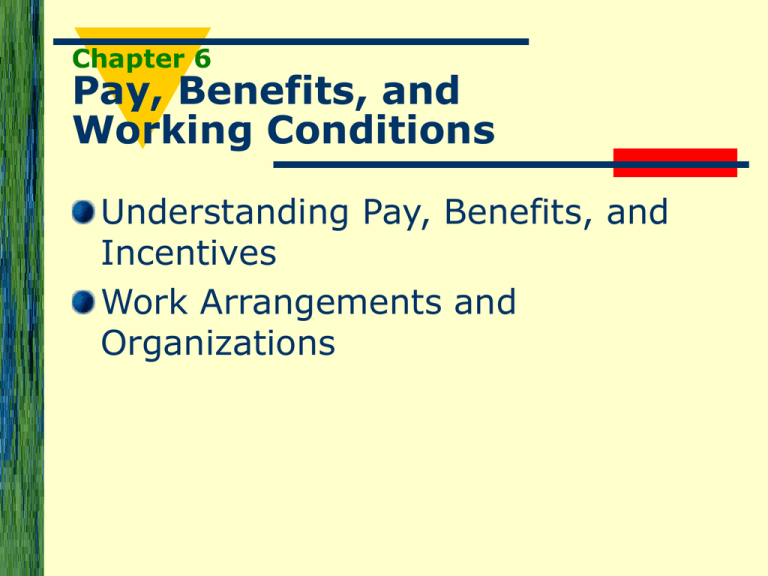Gross Pay, Deductions, and Net Pay
advertisement

Chapter 6 Pay, Benefits, and Working Conditions Understanding Pay, Benefits, and Incentives Work Arrangements and Organizations Gross Pay, Deductions, and Net Pay Gross Pay Total Pay Before Deductions Equals Hourly Wages + Overtime Hourly Wage Based on 40 Hour Work Week Overtime > 40 Hours Paid “time and a half” Gross Pay, Deductions, and Net Pay Salary Regular hours, but no overtime pay Deductions Amounts subtracted from gross pay Social Security* Federal* and State Income Tax* Medicare* Savings Contributions Health Insurance Costs Gross Pay, Deductions, and Net Pay Net pay “Take-home pay” Equals Gross Pay – Deductions Estimating Annual Salary Hourly Rate * 2000 $8.00/hour: $8.00 * 2000 = $16,000 Gross Pay, Deductions, and Net Pay Compute Gross Pay Regular hours worked: 40 Overtime hours worked: 9 Regular rate of pay: $7.50 Compute Gross Pay Regular hours worked: 45 Regular rate of pay: $8.15 Gross Pay, Deductions, and Net Pay Compute Gross Pay Regular salary: $854 per month Overtime rate: $12.54 per hour 12 hours of overtime Calculate Monthly Pay Annual pay: $27,500 Gross Pay, Deductions, and Net Pay Find State and Federal Withholding Taxes Single Person O Allowances Made $256 Last Week Gross Pay, Deductions, and Net Pay Find State and Federal Withholding Taxes Married Person 2 Allowances Made $846 Last Month Gross Pay, Deductions, and Net Pay Find State and Federal Withholding Taxes Married Person 4 Allowances Made $1,560 Last Month Benefits and Incentives Benefits – Part of compensation in addition to pay Profit Sharing Employee receives a portion of company profits “Incentive Pay” Increases productivity Paid vacations Typically two weeks per year to start Benefits and Incentives Paid Holidays Include Christmas, Thanksgiving, Labor Day, etc. If you work a holiday, “double time” or more Employee Services Extras such as discounts on merchandise, free parking, day-care, tuition reimbursement, etc. Benefits and Incentives Sick Pay Normally only available to full-time employees About 3 – 10 days per year Leaves of Absence Without pay, but provides job security Family Medical Leave Act (FMLA) 50+ employees, must give 12 weeks off per year for birth of child or illness of self or family member Guaranteed job when return and healthcare during leave Benefits and Incentives Insurance Health Usually your company has a set provider such as Blue Cross/Blue Shield Typically the employer pays for a portion and you pay for a portion Dental/Vision Employer chooses provider, share costs Life Used in case of your death to supplement lost income Pay cash to a “beneficiary” Benefits and Incentives Bonuses and stock options Another form of “incentive pay” Stock options give employees the right to buy a certain number of shares at a set price Travel Expenses May provide company car or reimburse miles driven on personal car “Expense Account” May be given a set daily allowance or must keep receipts to submit upon return Benefits and Incentives Pension and savings plans Pensions Provided by employer Receive a monthly check upon retirement “Vested” after a set number of years Vested means you are entitled to retirement benefits Employer-sponsored savings plans 401(k) and 403(b) Employee makes contribution to account, employer may match a portion Earnings grow tax-free Lesson 6.2 Work Arrangements and Organizations GOALS Explain flexible job arrangements, such as flexible schedules, job rotation, job sharing, and permanent part-time employment. Describe the role of unions and professional organizations in the workplace. Flexible Work Arrangements Altered workweeks Flextime Choose hours: 6-3, 7-4, 8-5, 9-6 Core time (most crucial to be there): 10-3 May decreases absenteeism Compressed workweek Instead of 5 days, 8 hours you’d work 4 days 10 hours Flexible Work Arrangements Job rotation Trained in more than one job Can switch/rotate between positions Greater job satisfaction Reduces boredom Helps when employees are absent Job sharing Two people share a full-time job Flexible Work Arrangements Permanent part-time Many are choosing to work 16-25 hours per week Saves employers money, while providing flexibility to workers Balance family/work life Telecommuting Work from home or on the road Stay in contact with manager via phone, email, internet Labor Unions and Professional Organizations Labor Unions Group of people in a similar occupation organized to protect rights of workers Workers pay union dues which support their own lawyers, doctors and public officials Labor Unions and Professional Organizations Functions of unions Recruit new members Engage in collective bargaining Negotiating terms of employment contracts – wages, benefits, management rights, etc. Support political candidates that favor unions Provide support services for workers Labor Unions and Professional Organizations Types of unions Craft unions Construction, railroad, printing Industrial unions Steel, automobile, industry Public-employee unions Police, teachers, firefighters Labor Unions and Professional Organizations Professional organizations Collect dues to provide the following Newsletters Conferences Workshops Some professions require members American Bar Association - lawyers Labor Unions and Professional Organizations Grievance A formal complaint against management for violating a contract Seniority Ranking of when each employee is hired Strike Union members refuse to work until an agreement is met Lobbying Supporting a political action or supporting legislation to benefit the profession










